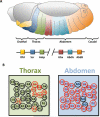Programmed cell death acts at different stages of Drosophila neurodevelopment to shape the central nervous system
- PMID: 27404003
- PMCID: PMC4983237
- DOI: 10.1002/1873-3468.12298
Programmed cell death acts at different stages of Drosophila neurodevelopment to shape the central nervous system
Abstract
Nervous system development is a process that integrates cell proliferation, differentiation, and programmed cell death (PCD). PCD is an evolutionary conserved mechanism and a fundamental developmental process by which the final cell number in a nervous system is established. In vertebrates and invertebrates, PCD can be determined intrinsically by cell lineage and age, as well as extrinsically by nutritional, metabolic, and hormonal states. Drosophila has been an instrumental model for understanding how this mechanism is regulated. We review the role of PCD in Drosophila central nervous system development from neural progenitors to neurons, its molecular mechanism and function, how it is regulated and implemented, and how it ultimately shapes the fly central nervous system from the embryo to the adult. Finally, we discuss ideas that emerged while integrating this information.
Keywords: Drosophila; apoptosis; neurodevelopment.
© 2016 Federation of European Biochemical Societies.
Figures




References
-
- Abdelwahid E, Yokokura T, Krieser RJ, Balasundaram S, Fowle WH, White K. Mitochondrial disruption in Drosophila apoptosis. Dev Cell. 2007;12(5):793–806. - PubMed
-
- Abrams JM, White K, Fessler LI, Steller H. Programmed cell death during Drosophila embryogenesis. Development. 1993;117(1):29–43. - PubMed
-
- Almeida MS, Bray SJ. Regulation of post-embryonic neuroblasts by Drosophila Grainyhead. Mech Dev. 2005;122(12):1282–1293. - PubMed
Publication types
MeSH terms
Grants and funding
LinkOut - more resources
Full Text Sources
Other Literature Sources
Molecular Biology Databases

